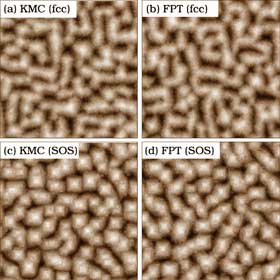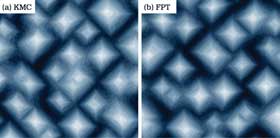Compiled by Photonics Spectra staff
A mathematical approach that accelerates the complex computer calculations used to simulate the formation of microthin materials was implemented recently by a physicist at the University of Toledo.
Physics professor Dr. Jacques Amar used the Ohio Supercomputer Center resources and Kinetic Monte Carlo (KMC) methods to simulate the molecular beam epitaxy (MBE) process, a technique that involves heating metals until they transition into a gaseous state and then reform as thin films by condensing on a wafer in single-crystal-thick layers. The advantage of MBE is its ability to control the deposition of thin films and atomic structures on the atomic scale to create nanostructures, Amar said.

Jacques Amar, a physicist at the University of Toledo, leveraged Ohio Supercomputer Center systems to test an accelerated approach to simulating thin-film growth. Using two models (fcc and SOS), he compared the regular Kinetic Monte Carlo (KMC) method (figures a and c) with a first-passage-time approach coupled with the KMC method (figures b and d). Images courtesy of J. Amar/University of Toledo.
Recently, he leveraged the center’s supercomputers to implement a first-passage-time (FPT) approach to speed up KMC simulations of the creation of materials just a few atoms thick. KMC methods have been used successfully to carry out a variety of simulations, but much of the time was “wasted” on rapid, repetitive low-barrier events, he said.
Although there are a variety of approaches to overcome the inefficiencies of the method, Amar used FPT to improve KMC processing speeds. Also known as first-hitting-time, FPT is a statistical model that sets a threshold for a process and then estimates certain factors, such as the probability that the process reaches that threshold within a certain amount of time, or the mean time until which the threshold is reached.

In tests, Amar compared the surface simulations of thin-film copper growth using regular (a) KMC methods and (b) first-passage-time distribution KMC simulations.
Amar and his colleagues targeted two atomic-level events for testing the FPT approach: edge diffusion and corner rounding. Edge diffusion involves the “hopping” movement of surface atoms (adatoms) along the edges of islands, which are formed as the material grows. Corner rounding involves the hopping of adatoms around island corners, leading to smoother islands.
He compared the KMC-FPT and regular KMC simulation approaches using several models of thin-film growth: Cu/Cu(100), fcc(100) and solid-on-solid (SOS). He also used two methods for calculating the FPT for these events, including the mean FPT and the full FPT distribution. His findings appeared in the June 10, 2011, issue of Physical Review B (doi: 10.1103/ PhysRevB.81.235415).
Amar found that both methods provided very good agreement between the FPT-KMC approach and regular KMC simulations, but that the FPT approach could lead to a significant speedup when compared with regular KMC simulations.